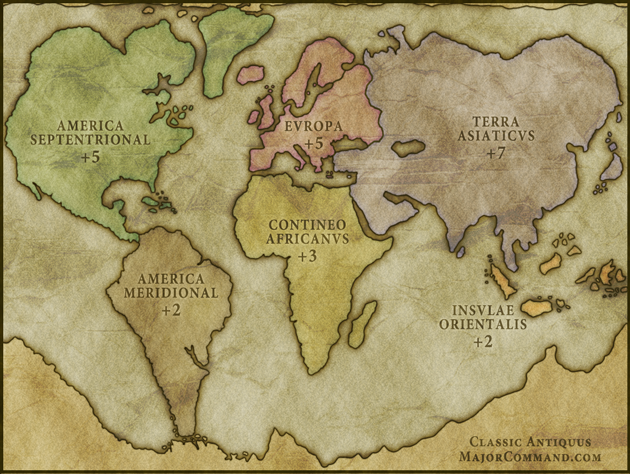Difference between revisions of "Classic Antiquus"
m (→Classic Antiquus: Possible image wrap fix) |
m |
||
| Line 1: | Line 1: | ||
[[Main Page|'''Back to Wiki Main Page''']] | [[Main Page|'''Back to Wiki Main Page''']] | ||
---- | ---- | ||
| − | ==Classic | + | ==''Classic Antiquu''s== |
[[File:ClassicAntiquusNames.jpg|927px]] | [[File:ClassicAntiquusNames.jpg|927px]] | ||
[[File:CA_brieftab.png|630px|thumb|right|Brief tab showing command bonuses]] | [[File:CA_brieftab.png|630px|thumb|right|Brief tab showing command bonuses]] | ||
| − | === | + | ===''Stats''=== |
Regions: 42<br>Commands: 6<br>Special Features: none | Regions: 42<br>Commands: 6<br>Special Features: none | ||
| − | === | + | ===''Strategy and Tips''=== |
Classic Antiquus is a medium-sized, standard-play map. Insulae Orientialis and America Meridional represent the smallest and easiest to control commands, each giving a +2 bonus for holding four regions. The islands may be the most attractive region with just a single point to defend, but be aware that once you control it there's nowhere to go - Terra Asiaticus is a vast command and difficult to hold. | Classic Antiquus is a medium-sized, standard-play map. Insulae Orientialis and America Meridional represent the smallest and easiest to control commands, each giving a +2 bonus for holding four regions. The islands may be the most attractive region with just a single point to defend, but be aware that once you control it there's nowhere to go - Terra Asiaticus is a vast command and difficult to hold. | ||
| Line 14: | Line 14: | ||
The map is ideally suited for three to six players and for team games of two to four players per side, though with 42 regions it is certainly playable by more. | The map is ideally suited for three to six players and for team games of two to four players per side, though with 42 regions it is certainly playable by more. | ||
| − | === | + | ===''History''=== |
I created this map in 2012 in response to requests for a world map with fewer regions than our Classic Evolved. The gameplay is very straightforward; 42 regions, six commands, no tricky play features; veterans of other gaming sites may be familiar with similar layouts, though the style and theme of our version are unique to MajorCommand. | I created this map in 2012 in response to requests for a world map with fewer regions than our Classic Evolved. The gameplay is very straightforward; 42 regions, six commands, no tricky play features; veterans of other gaming sites may be familiar with similar layouts, though the style and theme of our version are unique to MajorCommand. | ||
Revision as of 11:33, 30 August 2015
Classic Antiquus
Stats
Regions: 42
Commands: 6
Special Features: none
Strategy and Tips
Classic Antiquus is a medium-sized, standard-play map. Insulae Orientialis and America Meridional represent the smallest and easiest to control commands, each giving a +2 bonus for holding four regions. The islands may be the most attractive region with just a single point to defend, but be aware that once you control it there's nowhere to go - Terra Asiaticus is a vast command and difficult to hold.
The map is ideally suited for three to six players and for team games of two to four players per side, though with 42 regions it is certainly playable by more.
History
I created this map in 2012 in response to requests for a world map with fewer regions than our Classic Evolved. The gameplay is very straightforward; 42 regions, six commands, no tricky play features; veterans of other gaming sites may be familiar with similar layouts, though the style and theme of our version are unique to MajorCommand.
The stylistic inspiration came from 16th century maps by the likes of Ortelius, Ribero, and Mercator. While the size and shape of world was generally not in dispute (for the first time in history), mapmakers of the era were constantly revising their work as new information came in about the coastlines of Africa, Asia, and the New World. There were rumors of land sightings south of Indonesia, but Australia would not be officially "discovered" and mapped for another 200 years. Latin remained the preferred language of European mapmakers, though few could agree on what to call the new lands across the Atlantic.

